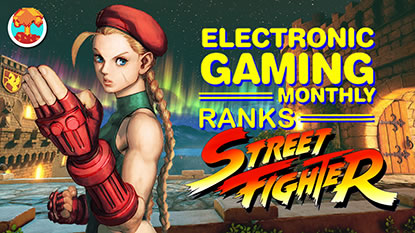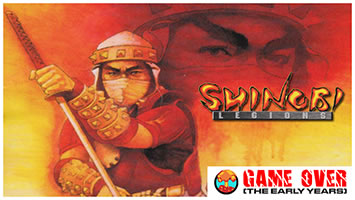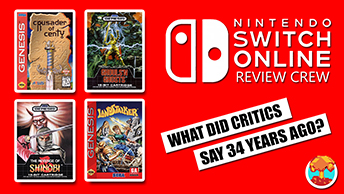- CLASSIC MAGAZINES
- REVIEW CREW
A show recapping what critics thought back
when classic games first came out! - NEXT GENERATION'S BEST & WORST
From the worst 1-star reviews to the best
5-stars can offer, this is Next Generation! - NINTENDO POWER (ARCHIVE)
Experience a variety of shows looking at the
often baffling history of Nintendo Power! - MAGAZINE RETROSPECTIVE
We're looking at the absolutely true history of
some of the most iconic game magazines ever! - SUPER PLAY'S TOP 600
The longest and most ambitious Super NES
countdown on the internet! - THEY SAID WHAT?
Debunking predictions and gossip found
in classic video game magazines! - NEXT GENERATION UNCOVERED
Cyril is back in this spin-off series, featuring the
cover critic review the art of Next Generation! - HARDCORE GAMER MAGAZING (PDF ISSUES)
Download all 36 issues of Hardcore Gamer
Magazine and relive the fun in PDF form!
- REVIEW CREW
- ELECTRONIC GAMING MONTHLY
- ELECTRONIC GAMING MONTHLY RANKS
From Mario to Sonic to Street Fighter, EGM
ranks classic game franchises and consoles! - ELECTRONIC GAMING MONTHLY BEST & WORST
Counting down EGM’s best and worst reviews
going year by year, from 1989 – 2009! - ELECTRONIC GAMING BEST & WORST AWARDS
11-part video series chronicling the ups and
downs of EGM’s Best & Worst Awards!
- ELECTRONIC GAMING MONTHLY RANKS
- GAME HISTORY
- GAME OVER: STORY BREAKDOWNS
Long-running series breaking down game
stories and analyzing their endings! - A BRIEF HISTORY OF GAMING w/ [NAME HERE]
Real history presented in a fun and pithy
format from a variety of game historians! - THE BLACK SHEEP
A series looking back at the black sheep
entries in popular game franchises! - INSTANT EXPERT
Everything you could possibly want to know
about a wide variety of gaming topics! - FREEZE FRAME
When something familiar happens in the games
industry, we're there to take a picture! - I'VE GOT YOUR NUMBER
Learn real video game history through a series
of number-themed episodes, starting at zero! - GREAT MOMENTS IN BAD ACTING
A joyous celebration of some of gaming's
absolute worst voice acting!
- GAME OVER: STORY BREAKDOWNS
- POPULAR SHOWS
- DG NEWS w/ LORNE RISELEY
Newsman Lorne Riseley hosts a regular
series looking at the hottest gaming news! - REVIEW REWIND
Cyril replays a game he reviewed 10+ years
ago to see if he got it right or wrong! - ON-RUNNING FEUDS
Defunct Games' longest-running show, with
editorials, observations and other fun oddities! - DEFUNCT GAMES QUIZ (ARCHIVE)
From online quizzes to game shows, we're
putting your video game knowledge to the test!- QUIZ: ONLINE PASS
Take a weekly quiz to see how well you know
the news and current gaming events! - QUIZ: KNOW THE GAME
One-on-one quiz show where contestants
find out if they actually know classic games! - QUIZ: THE LEADERBOARD
Can you guess the game based on the classic
review? Find out with The Leaderboard!
- QUIZ: ONLINE PASS
- DEFUNCT GAMES VS.
Cyril and the Defunct Games staff isn't afraid
to choose their favorite games and more! - CYRIL READS WORLDS OF POWER
Defunct Games recreates classic game
novelizations through the audio book format!
- DG NEWS w/ LORNE RISELEY
- COMEDY
- GAME EXPECTANCY
How long will your favorite hero live? We crunch
the numbers in this series about dying! - VIDEO GAME ADVICE
Famous game characters answer real personal
advice questions with a humorous slant! - FAKE GAMES: GUERILLA SCRAPBOOK
A long-running series about fake games and
the people who love them (covers included)! - WORST GAME EVER
A contest that attempts to create the worst
video game ever made, complete with covers! - LEVEL 1 STORIES
Literature based on the first stages of some
of your favorite classic video games! - THE COVER CRITIC
One of Defunct Games' earliest shows, Cover
Critic digs up some of the worst box art ever! - COMMERCIAL BREAK
Take a trip through some of the best and
worst video game advertisements of all time! - COMIC BOOK MODS
You've never seen comics like this before.
A curious mix of rewritten video game comics!
- GAME EXPECTANCY
- SERIES ARCHIVE
- NINTENDO SWITCH ONLINE ARCHIVE
A regularly-updated list of every Nintendo
Switch Online release, plus links to review! - PLAYSTATION PLUS CLASSIC ARCHIVE
A comprehensive list of every PlayStation
Plus classic release, including links! - RETRO-BIT PUBLISHING ARCHIVE
A regularly-updated list of every Retro-Bit
game released! - REVIEW MARATHONS w/ ADAM WALLACE
Join critic Adam Wallace as he takes us on a
classic review marathon with different themes!- DEFUNCT GAMES GOLF CLUB
Adam Wallace takes to the links to slice his way
through 72 classic golf game reviews! - 007 IN PIXELS
Adam Wallace takes on the world's greatest spy
as he reviews 15 weeks of James Bond games! - A SALUTE TO VAMPIRES
Adam Wallace is sinking his teeth into a series
covering Castlevania, BloodRayne and more! - CAPCOM'S CURSE
Adam Wallace is celebrating 13 days of Halloween
with a line-up of Capcom's scariest games! - THE FALL OF SUPERMAN
Adam Wallace is a man of steel for playing
some of the absolute worst Superman games! - THE 31 GAMES OF HALLOWEEN
Adam Wallace spends every day of October afraid
as he reviews some of the scariest games ever! - 12 WEEKS OF STAR TREK
Adam Wallace boldly goes where no critic has
gone before in this Star Trek marathon!
- DEFUNCT GAMES GOLF CLUB
- DAYS OF CHRISTMAS (ARCHIVE)
Annual holiday series with themed-episodes
that date all the way back to 2001!- 2015: 30 Ridiculous Retro Rumors
- 2014: 29 Magazines of Christmas
- 2013: 29 Questionable Power-Ups of Christmas
- 2012: 34 Theme Songs of Christmas
- 2011: 32 Game Endings of Christmas
- 2010: 31 Bonus Levels of Christmas
- 2009: 30 Genres of Christmas
- 2008: 29 Controls of Christmas
- 2007: 34 Cliches of Christmas
- 2006: 33 Consoles of Christmas
- 2005: 32 Articles of Christmas
- 2004: 31 Websites of Christmas
- 2003: 29 Issues of Christmas
- 2002: 28 Years of Christmas
- 2001: 33 Days of Christmas
- NINTENDO SWITCH ONLINE ARCHIVE
- REVIEW ARCHIVE
- FULL ARCHIVE
A Brief History of Cheat Codes in Magazines
Welcome to the 32 Dangerous Cheat Codes, a brand new series that will run daily between November 24 and December 25. Join us as we discuss the hazardous ramifications of some of your favorite cheat codes.
Today we're taking a break from the typical cheat codes and looking at the magazines that published them. We talk about a twenty year history that involves Electronic Gaming Monthly, GamePro, Die Hard Game Fan, Video Games & Computer Entertainment, CVG and more. All this on the newest episode of the 32 Dangerous Cheat Codes.
After four weeks of talking about big heads, minus worlds, secret screens, debug modes and exploitable passwords, I wanted to turn the attention to the magazines that published the cheat codes. From Electronic Gaming Monthly to GamePro to Die Hard Game Fan, every publication had their own unique spin on the tips and tricks section.
You have to understand that this was a time before everybody had the internet, so the only way to hear about the Aladdin level skip or Street Fighter II's bonus costumes was to get the hook-up from a friend or seek out every game magazine you could find. These days you just have to go to GameFAQs or dozens of other code sites, but it wasn't that easy in the late 1980s and early 90s. I would also mention that we had to walk uphill in the snow both ways, but I think that's pretty much a given.
For many Americans, Nintendo Power was the gateway drug for cheat codes. Instead of writing hard-hitting news stories or offering opinionated reviews, the magazine chose to fill up the pages with exhaustive and high-detailed strategy guides. But beyond printing usual dungeon maps and level guides, Nintendo Power also published traditional cheat codes in a section known as Classified Information. This eventually led way to a comprehensive guide book that collected all of the NES, Super NES and Game Boy codes printed over the years.
Tricks of the Trade is what Electronic Gaming Monthly called their cheat code section, and it was a staple of the magazine for most if its run. In the early days, EGM would rate each code using up to five stars. This was later abandoned, replaced by a straight cheat code section with neither bells nor whistles. This eventually led to the magazine trying to make the section more interactive, asking readers to help them crack hard-to-believe codes.
Of course, asking the readers for help was nothing new. GamePro would routinely give t-shirts to anybody that got their code published, which led to the plagiarism issue we talked about on yesterday's episode. On top of having a dedicated cheat code section known as S.W.A.T.: Secret Weapons and Tactics, GamePro would also add little "protips" alongside their overly friendly reviews. The code section proved to be so popular that GamePro attempted to spin it off into its own magazine called S.W.A.T.Pro.
Believe it or not, GamePro wasn't the only magazine to attempt this type of spin-off. Video Games & Computer Entertainment started out with a fairly unspectacular cheat code section before giving it a full make-over and creating Tips & Tricks magazine. This not only proved to be a good business move, but actually outlasted both Video Games & Computer Entertainment and the rebranded VideoGames magazines.
While most magazines had a variation on the cheat code section, they all handled it a little differently. We saw Die Hard Game Fan invent a fun animated character in charge of providing the freshest cheat codes. Mean Machines Sega prided itself on giving user-friendly tips for European, American and Japanese games. Raze, on the other hand, had Hacks & Stacks, which sounds cool, but doesn't make a lot of sense. And don't forget about CVG, which collected codes for both consoles and computers at a time when those two were usually segregated.
You don't see these types of cheat codes listed in magazines anymore. For one thing, there aren't that many video game magazines still kicking, and most people would rather turn to the internet for cheat codes than thumb through a bunch of Game Informer issues. It also doesn't help that many of today's biggest video games have ditched cheat codes entirely, leaving these publications with nothing to print.
In an age before the internet, these magazines were a great source for level selects, sound tests and unlimited continues. It was often the reason why gamers subscribed to Nintendo Power and GamePro, and it remained one of the most popular sections for decades. As compelling as it is to talk about classic reviews and old school rumors, you should never forget the importance of the tips and tricks section.
After four weeks of talking about big heads, minus worlds, secret screens, debug modes and exploitable passwords, I wanted to turn the attention to the magazines that published the cheat codes. From Electronic Gaming Monthly to GamePro to Die Hard Game Fan, every publication had their own unique spin on the tips and tricks section.
You have to understand that this was a time before everybody had the internet, so the only way to hear about the Aladdin level skip or Street Fighter II's bonus costumes was to get the hook-up from a friend or seek out every game magazine you could find. These days you just have to go to GameFAQs or dozens of other code sites, but it wasn't that easy in the late 1980s and early 90s. I would also mention that we had to walk uphill in the snow both ways, but I think that's pretty much a given.
For many Americans, Nintendo Power was the gateway drug for cheat codes. Instead of writing hard-hitting news stories or offering opinionated reviews, the magazine chose to fill up the pages with exhaustive and high-detailed strategy guides. But beyond printing usual dungeon maps and level guides, Nintendo Power also published traditional cheat codes in a section known as Classified Information. This eventually led way to a comprehensive guide book that collected all of the NES, Super NES and Game Boy codes printed over the years.
Tricks of the Trade is what Electronic Gaming Monthly called their cheat code section, and it was a staple of the magazine for most if its run. In the early days, EGM would rate each code using up to five stars. This was later abandoned, replaced by a straight cheat code section with neither bells nor whistles. This eventually led to the magazine trying to make the section more interactive, asking readers to help them crack hard-to-believe codes.
Of course, asking the readers for help was nothing new. GamePro would routinely give t-shirts to anybody that got their code published, which led to the plagiarism issue we talked about on yesterday's episode. On top of having a dedicated cheat code section known as S.W.A.T.: Secret Weapons and Tactics, GamePro would also add little "protips" alongside their overly friendly reviews. The code section proved to be so popular that GamePro attempted to spin it off into its own magazine called S.W.A.T.Pro.
Believe it or not, GamePro wasn't the only magazine to attempt this type of spin-off. Video Games & Computer Entertainment started out with a fairly unspectacular cheat code section before giving it a full make-over and creating Tips & Tricks magazine. This not only proved to be a good business move, but actually outlasted both Video Games & Computer Entertainment and the rebranded VideoGames magazines.
While most magazines had a variation on the cheat code section, they all handled it a little differently. We saw Die Hard Game Fan invent a fun animated character in charge of providing the freshest cheat codes. Mean Machines Sega prided itself on giving user-friendly tips for European, American and Japanese games. Raze, on the other hand, had Hacks & Stacks, which sounds cool, but doesn't make a lot of sense. And don't forget about CVG, which collected codes for both consoles and computers at a time when those two were usually segregated.
You don't see these types of cheat codes listed in magazines anymore. For one thing, there aren't that many video game magazines still kicking, and most people would rather turn to the internet for cheat codes than thumb through a bunch of Game Informer issues. It also doesn't help that many of today's biggest video games have ditched cheat codes entirely, leaving these publications with nothing to print.
In an age before the internet, these magazines were a great source for level selects, sound tests and unlimited continues. It was often the reason why gamers subscribed to Nintendo Power and GamePro, and it remained one of the most popular sections for decades. As compelling as it is to talk about classic reviews and old school rumors, you should never forget the importance of the tips and tricks section.
HOME |
CONTACT |
NOW HIRING |
WHAT IS DEFUNCT GAMES? |
NINTENDO SWITCH ONLINE |
RETRO-BIT PUBLISHING
Retro-Bit |
Switch Planet |
The Halcyon Show |
Same Name, Different Game |
Dragnix |
Press the Buttons
Game Zone Online | Hardcore Gamer | The Dreamcast Junkyard | Video Game Blogger
Dr Strife | Games For Lunch | Mondo Cool Cast | Boxed Pixels | Sega CD Universe | Gaming Trend
Game Zone Online | Hardcore Gamer | The Dreamcast Junkyard | Video Game Blogger
Dr Strife | Games For Lunch | Mondo Cool Cast | Boxed Pixels | Sega CD Universe | Gaming Trend
Copyright © 2001-2025 Defunct Games
All rights reserved. All trademarks are properties of their respective owners.
All rights reserved. All trademarks are properties of their respective owners.

























